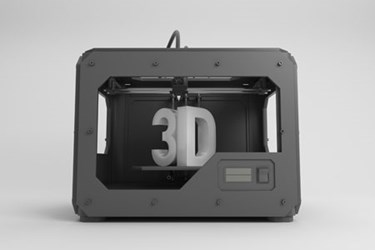FDA Issues Draft Guidance For 3D-Printed Medical Devices
By Jof Enriquez,
Follow me on Twitter @jofenriq

The U.S. Food and Drug Administration (FDA) has released draft guidance containing technical considerations in additive manufacturing (AM), the broad category of manufacturing encompassing 3-dimensional (3D) printing. The "leap-frog" guidance adds some clarity regarding FDA's initial approach to anticipated regulation of a growing number of 3D-printed medical devices.
The draft guidance addresses two areas of medical device development: Design and Manufacturing Considerations, which contains technical considerations that should be addressed as part of fulfilling Quality System (QS) requirements; and Device Testing Considerations, which describes the type of information that should be provided in premarket notification submissions [510(k)], premarket approval (PMA) applications, humanitarian device exemption (HDE) applications, de novo requests, and investigational device exemption (IDE) applications for an AM device.
FDA says the section on Design and Manufacturing Considerations is not meant to be comprehensive. Nevertheless, the agency included recommendations on device design, software workflow, material controls, post-processing, quality data, and process validation and acceptance activities. In the second section pertaining to Device Testing, FDA provided recommendations on device descriptions, mechanical testing, dimensional measurements, material characterization, cleaning and sterilization, biocompatibility, and additional labeling considerations.
The document was based on industry stakeholder feedback from a 2014 public workshop organized by FDA. The agency is accepting comments on the draft guidance through Aug. 8, 2016.
The agency clarifies that the guidance does not cover the use or incorporation of biological, cellular, or tissue-based products in AM, or point-of-care 3D-device manufacturing. These could be addressed in future guidance and/or regulatory pathways for 3D printing which continue to evolve, according to the agency.
As defined in the draft guidance, AM is a process that builds an object by iteratively building 2-dimensional (2D) layers and joining each to the layer below, allowing device manufacturers to rapidly alter designs without the need for retooling, and to create complex devices built as a single piece. For medical devices, AM has the advantage of facilitating the creation of anatomically-matched devices and surgical instrumentation by using a patient’s own medical imaging, and allows the creation of complex structures not possible through traditional manufacturing techniques.
According to RAPS, so far, FDA has cleared more than 85 applications for 3D-printed devices, although none have been high-risk devices requiring premarket approval.
"If it is unclear what technical information should be provided in a premarket submission for an AM device, we strongly encourage manufacturers to engage with FDA through the Pre-Submission process to obtain more detailed feedback," FDA wrote.
